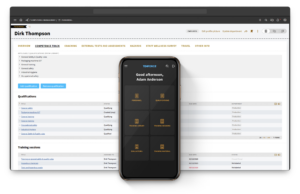Competence Management – Why Doing It Right Matters
59% of companies are still struggling to organize and complete training, even when it is required by law.1 More worrying still — companies without a proper training program are experiencing a 24% higher rate of workplace incidents than those with such programs.2
Putting the human cost of workplace incidents aside, there’s a pretty hefty price tag attached too. 15% of OSHA’s most frequently issued citations are related to employers failing to provide required training. In 2019 alone, these fines amounted to over $61 million.3
So, it’s clear: having well-trained employees is crucial to workplace safety and success. In fact, if your employees get in 20 hours of safety training each year, they’re nearly 70% more likely to stick to safety rules than those who don’t.4
The bottom line? It’s time to step up your game when it comes to competence management. Your employees and your business will thank you.
What are the main challenges of competence management?
But why are so many companies struggling with competence management?
A big part of the issue arises from a reliance on spreadsheets. When it comes to tracking competencies, they just can’t keep up with who’s got the skills and qualifications you need to run a safe and efficient workplace. This makes creating skills matrices and conducting gap analyses an uphill battle.
And what about keeping tabs on employees’ progress and nudging them to complete training? Not to mention rescheduling essential training. Without a robust follow-up process, 24% of organizations are worried that even when employees do complete training, they won’t hang onto that knowledge long enough to influence their future behavior.5 But issuing email reminders and follow-ups can become a time-consuming task that opens you up to delays and compliance risks.
From struggle to success: How technology transforms training

This is where EHSQ software steps in, offering a solution that automates training programs, streamlines scheduling, and reduces administrative overhead. With TenForce you can:
- Create detailed profiles including qualifications, certifications, and skills for each employee.
- Automatically detect skills gaps and generate targeted training programs.
- Notify employees of their assigned training tasks and track their progress.
- Automate the scheduling of refresher training and certification renewals.
- Centralize and maintain up-to-date training records, reducing the risk of data discrepancies.
- Build an extensive library of training programs and evaluation methods.
- Generate compliance-ready reports for stakeholders with instant data visualization.
By automating competence management, you ensure that everyone stays in the loop about the necessary training and takes responsibility for completing it promptly. It’s no surprise, then, that companies using software to oversee their training initiatives were 20% more likely to hit that golden 20-hour milestone compared to those who weren’t.6
Competence management software in action: Watch our hands-on demo
The importance of competence management cannot be overstated, the statistics speak for themselves. And failing to schedule and complete training can lead to not just human costs, but also substantial financial ones, with fines adding up to millions.
The good news is, you don’t have to struggle with competence management any longer!
Watch our on-demand webinar, for a hands-on demonstration of TenForce’s Competence Management, that’ll show you how to:
- Plan and execute employee training effectively.
- Keep track of all the diverse skills required in your workplace.
- Maintain a centralized view of all your employees’ skills.
- Monitor competence tracks with real-time analysis and advanced dashboards.
Watch The Lean Approach to Digital Competence Management webinar for free
[1] State of Workplace Safety Training Report – Intertek Alchemy – Workforce Training, Technology & Consulting. Published December 9, 2022. https://www.alchemysystems.com/content/research/state-of-workplace-safety-training/
[2] Waehrer, Geetha M, and Ted R Miller. 2009. “Does Safety Training Reduce Work Injury in the United States?” ResearchGate. Ergonomics Open Journal. 2: 26-39
[3] Druley, K. November 2019. OSHA’s Top 10 most cited violations for 2019. Safety+Health. https://www.safetyandhealthmagazine.com/articles/19087-oshas-top-10-most-cited-violations
[4 – 6] State of Workplace Safety Training Report – Intertek Alchemy
